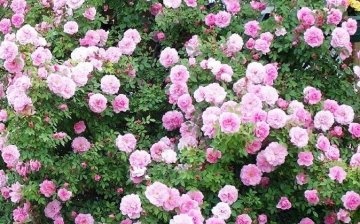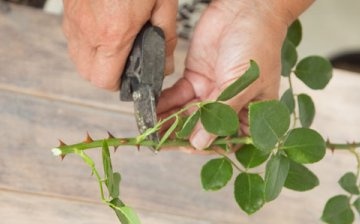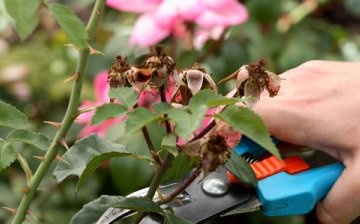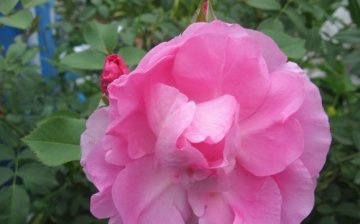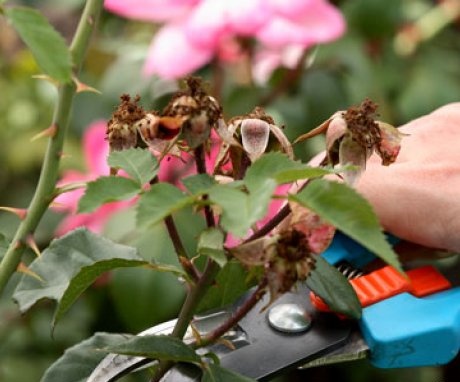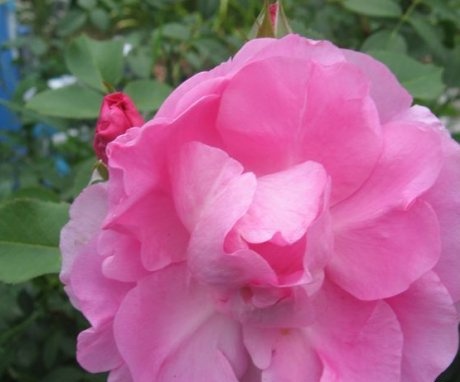Park rose John Davis - the highlight of your garden
Park views roses preferred by many gardeners because they possess the resilience of their wild relatives and the sophistication of the aristocratic species. These include the John Davis variety, bred by Canadian breeders.
Content:
- Description of the variety
- We correctly propagate and plant a park rose
- Rose Bushes Care Tips John Davis
- The use of varieties in landscape design
Description of the variety
The varieties of park roses brought from Canada get along well in a harsh climate, without requiring special preparation for winter conditions. They are hybrids of wild rose hips and rugosa rose, forming shrubs with lush foliage to the ground, delighting with large flowers with a faint smell.
Their main advantage is the ability to recover even after freezing of the overground buds.
Rose features:
- John Davis attracts with the beauty of his flowers, which range in color from deep pink in the middle to faded pale tones at the ends.
- The flowers, consisting of a large number of petals, usually open fully, exposing the golden stamens.
- All buds are collected in a brush with ten to fifteen specimens, which are up to eight centimeters in diameter.
- The bush begins to bloom in June, without stopping it all summer, at first very abundantly, then more moderately.
- Roses do not have a pungent smell, but give a little light fruity-spicy notes.
- The John Davis variety has a powerful bush, sometimes reaching a height of two meters.
- It is completely strewn with glossy green leafy, rather lush.
- There are few thorns on the plant, and the internodes are short.
Outwardly, the rose bush looks sloppy, since it does not differ in compactness, but disintegrates into separate parts. But by tying it to the supports, you can achieve a form pleasing to the eye. For the winter, rose bushes shed their foliage. The Canadian hybrid John Davis attracts not only with its frost resistance, but also with its magnificent appearance.
We correctly propagate and plant a park rose
For reproduction of a favorite variety roses use several breeding methods:
- In the off-season, before the buds bloom on the roses, the bush is dug out by cutting off its branches. With the help of a sharp tool - a pruner, a knife - they divide the plant into parts so that each has at least one shoot. After that, the resulting bushes are planted, deepening them five centimeters into the ground. Do not forget about watering, hilling roses after planting.
- Near the mother bush, straight shoots are often visible, offspring that do not have their own roots. After rooting, a year later, they are separated from the mother, planting in a new place.
- Breeding method cuttings suitable for the variety of park John Davis, but requires special preparation and diligence. Cuttings with one or two internodes from a flower are taken in the middle of summer, having prepared a special greenhouse for planting them. First, they dig a hole, filling it halfway with fresh manure. After that, it is covered with a film, leaving it for a week to warm up. After that, soil is poured, consisting of fertile soil: the same amount of humus is mixed with peat, adding a little river sand on top. The cuttings are placed in the soil to a depth of 2 centimeters with a lower oblique cut, having previously processed it with Kornevin.After that, it is imperative to spray the plantings with water and cover them with foil. Planted cuttings are watered and ventilated daily. As soon as callus appears after 2-3 weeks, the cover is removed. And after 15 days, development will occur root system... In autumn breeding, the bushes are left in a greenhouse, and in the spring they are planted in a permanent place.
The ideal soil for the John Davis rose will be moderately sour, and the place will be a well-lit area of the garden, preferably a hillock. The timing of planting park flower species begins from May to September in pre-prepared pits to a depth of no more than 8 centimeters.
The main conditions for growing a rose include the sufficiency of natural light, high permeability of the soil to air and moisture, and regular watering.
Rose Bushes Care Tips John Davis
The requirements for caring for a frost-resistant variety do not differ from others suitable for park species:
- The main care is abundant watering, especially during the period of intensive spring development and in summer during flowering... In case of drought, watered several times a week, soaking the soil deep into the depths of half a meter. The best time to water is evening. In the fall, the amount of watering is reduced.
- It is necessary to feed the planting of roses in the spring mineral fertilizers, which are prepared from twenty grams of ammonium nitrate, thirty - superphosphates, ten - potassium salt, diluted in ten liters of water. Five liters of solution are applied under each bush, not forgetting to then water the plants. After blooming the leaves on the roses, they bring fermented mullein, and during the appearance of buds - thirty grams of superphosphate, diluted in a bucket of water, with the calculation of three liters per plant.
- The annual pruning bushes are carried out in the spring in order to eliminate dry and diseased branches.
- Before winter rose bushes spudwrapped in several layers of kraft paper or felt.
The requirements for caring for a park rose increase in the first three years of its formation.
The use of varieties in landscape design
Due to the height of two meters, John Davis roses are best planted in a composition of three to four bushes with different shades of color. Such groups look good in the shade of conifers. Surround the plantings with curly daylilies, awl-shaped carnations, armeria, lupine, astilboy... Perfectly set off the beauty of the flower junipers, landing sage... It is good to arrange a resting place near the bushes of park roses planted on a dark green lawn, admiring the gentle beauties of the garden with a cup of morning coffee.
If you want to arrange a rose garden, then for the John Davis variety, a place in the center, surrounded by hybrid tea dwarfs, is suitable. Regular types of flower beds should have clear shapes, borders with rose bushes of the same height. But landscape ones are more free in design, they should produce the appearance of natural thickets. Inside the rose garden there may be paths, paths, which will allow you to approach your favorite rose, smell it, and pluck it for a bouquet.
Single bushes by John Davis also look natural, once again drawing attention to their charm.
You can use the bushes for hedge or for planting along the fence, planting them at a distance of seventy centimeters from each other. Do not forget about the illumination of these areas, because the queen of flowers loves the sun so much. Do not break rose gardens near water bodies, as dense fogs, constant dampness can destroy plants. A variety like John Davis should play a major role in garden decoration.
More information can be found in the video:




